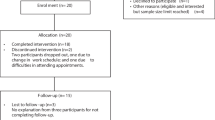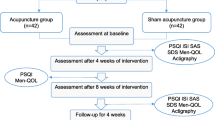Abstract
Purpose
Evaluate effects of electro-acupuncture (EA) and hormone therapy (HT) on health-related quality-of-life (HRQoL) and sleep in breast cancer survivors with vasomotor symptoms.
Methods
Forty-five women, randomized to EA (n = 27) for 12 weeks or HT (n = 18) for 24 months, were followed for up to 2 years. Distress caused by, and numbers of, hot flushes, hours slept and times woken up/night, Psychological and General Well-being Index (PGWB) and Women’s Health Questionnaire (WHQ) were registered before and during treatment and at 6, 9, 12, 18 and 24 months after start of treatment.
Results
After 12 weeks of EA (n = 19), WHQ improved from 0.32 (IQR 0.23–0.53) at baseline to 0.24 (IQR 0.12–0.39; p < 0.001) and PGWB from 78 (IQR 53–89) to 79 (IQR 68–93; p = 0.002). All sleep parameters improved and Hot Flush Score (HFS) decreased by 80%. At 12 months, WHQ, PGWB and all sleep parameters remained significantly improved (n = 14) and HFS decreased by 65%. After 12 weeks of HT (n = 18), WHQ improved from 0.29 (IQR 0.15–0.44) at baseline to 0.15 (IQR 0.05–0.22; p = 0.001), PGWB from 75 (IQR 59–88) to 90 (62–97; p = 0.102) and three of five sleep parameters improved.
Conclusion
Both EA and HT increased HRQoL and sleep, probably through decreasing numbers of and distress by hot flushes. Although flushes decreased less in the EA group than in the HT group, HRQoL improved at least to the same extent maybe due to other effects of EA, not induced by HT, e.g. on anxiety, vitality and sleep, supported by subscale analyses. EA should be further evaluated as treatment for women with breast cancer and climacteric complaints, since HT no longer can be recommended for these women.

Similar content being viewed by others
References
Montazeri A (2009) Quality of life data as prognostic indicators of survival in cancer patients: an overview of the literature from 1982 to 2008. Health Qual Life Outcomes 7:102
Montazeri A (2008) Health-related quality of life in breast cancer patients: a bibliographic review of the literature from 1974 to 2007. J Exp Clin Cancer Res 27:32
Bower JE, Ganz PA, Desmond KA, Rowland JH, Meyerowitz BE, Belin TR (2000) Fatigue in breast cancer survivors: occurrence, correlates, and impact on quality of life. J Clin Oncol 18:743–753
Barsevick A, Frost M, Zwinderman A, Hall P, Halyard M (2010) I'm so tired: biological and genetic mechanisms of cancer-related fatigue. Qual Life Res 19:1419–1427
Broeckel JA, Jacobsen PB, Horton J, Balducci L, Lyman GH (1998) Characteristics and correlates of fatigue after adjuvant chemotherapy for breast cancer. J Clin Oncol 16:1689–1696
Okuyama T, Akechi T, Kugaya A, Okamura H, Imoto S, Nakano T, Mikami I, Hosaka T, Uchitomi Y (2000) Factors correlated with fatigue in disease-free breast cancer patients: application of the Cancer Fatigue Scale. Support Care Cancer 8:215–222
Gupta P, Sturdee D, Pallin S, Majumder K, Fear R, Marshall T, Paterson I (2006) Menopausal symptoms in women treated for breast cancer; the prevalence and severity of symptoms and their perceived effects on quality of life. Climacteric 9:49–58
Savard J, Davidson JR, Ivers H, Quesnel C, Rioux D, Dupere V, Lasnier M, Simard S, Morin CM (2004) The association between nocturnal hot flashes and sleep in breast cancer survivors. J Pain Symptom Manage 27:513–522
Rand KL, Otte JL, Flockhart D, Hayes D, Storniolo AM, Stearns V, Henry NL, Nguyen A, Lemler S, Hayden J, Jeter S, Carpenter JS (2011) Modeling hot flushes and quality of life in breast cancer survivors. Climacteric 14:171–180. doi:10.3109/13697131003717070
Kronenberg F (1990) Hot flashes: epidemiology and physiology. Ann NY Acad Sci 592:52–86, discussion 123–133
Harris PF, Remington PL, Trentham-Dietz A, Allen CI, Newcomb PA (2002) Prevalence and treatment of menopausal symptoms among breast cancer survivors. J Pain Symptom Manage 23:501–509
Cella D, Fallowfield L (2008) Recognition and management of treatment-related side effects for breast cancer patients receiving adjuvant endocrine therapy. Breast Cancer Res Treat 107:167–180
Fahlen M, Wallberg B, von Schoultz E, Carlstrom K, Svensson G, Wilking N, Brandberg Y (2010) Health-related quality of life during hormone therapy after breast cancer: a randomized trial. Climacteric Epub ahead. doi:10.3109/13697131003660593
Chlebowski RT, Hendrix SL, Langer RD, Stefanick ML, Gass M, Lane D, Rodabough RJ, Gilligan MA, Cyr MG, Thomson CA, Khandekar J, Petrovitch H, McTiernan A (2003) Influence of estrogen plus progestin on breast cancer and mammography in healthy postmenopausal women: the women's health initiative randomized trial. JAMA 289:3243–3253
Beral V (2003) Breast cancer and hormone-replacement therapy in the Million Women Study. Lancet 362:419–427
Holmberg L, Iversen OE, Rudenstam CM, Hammar M, Kumpulainen E, Jaskiewicz J, Jassem J, Dobaczewska D, Fjosne HE, Peralta O, Arriagada R, Holmqvist M, Maenpaa J (2008) Increased risk of recurrence after hormone replacement therapy in breast cancer survivors. J Natl Cancer Inst 100:475–482
Filshie J, Bolton T, Browne D, Ashley S (2005) Acupuncture and self acupuncture for long-term treatment of vasomotor symptoms in cancer patients–audit and treatment algorithm. Acupunct Med 23:171–180
Walker EM, Rodriguez AI, Kohn B, Ball RM, Pegg J, Pocock JR, Nunez R, Peterson E, Jakary S, Levine RA (2010) Acupuncture versus venlafaxine for the management of vasomotor symptoms in patients with hormone receptor-positive breast cancer: a randomized controlled trial. J Clin Oncol 28:634–640
MacPherson H, Altman DG, Hammerschlag R, Li Y, Wu T, White A, Moher D (2010) Revised STandards for Reporting Interventions in Clinical Trials of Acupuncture (STRICTA): extending the CONSORT statement. Acupunct Med 28:83–93
Wyon YLR, Lundeberg T, Hammar M (1995) Effects of acupuncture on climacteric vasomotor symptoms, quality of life, and urinary excretion of neuropeptides among postmenopausal women. Menopause 2:3–12
Sloan JA, Loprinzi CL, Novotny PJ, Barton DL, Lavasseur BI, Windschitl H (2001) Methodologic lessons learned from hot flash studies. J Clin Oncol 19:4280–4290
Wiklund I, Karlberg J, Lindgren R, Sandin K, Mattsson LA (1993) A Swedish version of the Women's Health Questionnaire. A measure of postmenopausal complaints. Acta Obstet Gynecol Scand 72:648–655
Hunter M (1992) The Women´s Health Questionnaire: a measure of mid-aged women´s perceptions of their emotional and physical health. Psychol Health 7:45–54
Dupuy HJ (1984) The Psychological General Well-Being (PGWB) index. Le Jacq Publishing Inc, New York
Wiklund I, Karlberg J (1991) Evaluation of quality of life in clinical trials. Selecting quality-of-life measures. Control Clin Trials 12:204S–216S
Croog SH, Levine S, Testa MA, Brown B, Bulpitt CJ, Jenkins CD, Klerman GL, Williams GH (1986) The effects of antihypertensive therapy on the quality of life. N Engl J Med 314:1657–1664
Frisk J, Carlhall S, Kallstrom AC, Lindh-Astrand L, Malmstrom A, Hammar M (2008) Long-term follow-up of acupuncture and hormone therapy on hot flushes in women with breast cancer: a prospective, randomized, controlled multicenter trial. Climacteric 11:166–174
Lee HJ, Lee JH, Lee EO, Lee HJ, Kim KH, Lee KS, Lee CH, Nam DW, Kim SH, Lee HJ, Ahn KS (2009) Substance P and beta endorphin mediate electroacupuncture induced analgesic activity in mouse cancer pain model. Acupunct Electrother Res 34:27–40
Han JS (2004) Acupuncture and endorphins. Neurosci Lett 361:258–261
Thornton AA, Madlensky L, Flatt SW, Kaplan RM, Pierce JP (2005) The impact of a second breast cancer diagnosis on health related quality of life. Breast Cancer Res Treat 92:25–33
Pariente J, White P, Frackowiak RS, Lewith G (2005) Expectancy and belief modulate the neuronal substrates of pain treated by acupuncture. Neuroimage 25:1161–1167
Qin W, Tian J, Bai L, Pan X, Yang L, Chen P, Dai J, Ai L, Zhao B, Gong Q, Wang W, von Deneen K, Liu Y (2008) FMRI connectivity analysis of acupuncture effects on an amygdala-associated brain network. Mol Pain 4:55
Alfhaily F, Ewies AA (2007) Acupuncture in managing menopausal symptoms: hope or mirage? Climacteric 10:371–380
Hegadoren KM, O'Donnell T, Lanius R, Coupland NJ, Lacaze-Masmonteil N (2009) The role of beta-endorphin in the pathophysiology of major depression. Neuropeptides 43:341–353
Pluchino N, Merlini S, Cubeddu A, Giannini A, Bucci F, Casarosa E, Cela V, Angioni S, Luisi M, Genazzani AR (2009) Brain-region responsiveness to DT56a (Femarelle) administration on allopregnanolone and opioid content in ovariectomized rats. Menopause 16:1037–1043
Akhan SE, Gurel T, Has R, Iyibozkurt AC, Turfanda A (2002) Effects of long-term oral hormone replacement therapy on plasma nitric oxide and beta-endorphin levels in postmenopausal women. Gynecol Obstet Investig 54:196–200
ter Riet G, de Craen AJ, de Boer A, Kessels AG (1998) Is placebo analgesia mediated by endogenous opioids? A systematic review. Pain 76:273–275
Maclennan AH, Broadbent JL, Lester S, Moore V (2004) Oral oestrogen and combined oestrogen/progestogen therapy versus placebo for hot flushes. Cochrane Database Syst Rev CD002978
Pockaj BA, Gallagher JG, Loprinzi CL, Stella PJ, Barton DL, Sloan JA, Lavasseur BI, Rao RM, Fitch TR, Rowland KM, Novotny PJ, Flynn PJ, Richelson E, Fauq AH (2006) Phase III double-blind, randomized, placebo-controlled crossover trial of black cohosh in the management of hot flashes: NCCTG Trial N01CC1. J Clin Oncol 24:2836–2841
Carpenter JS, Storniolo AM, Johns S, Monahan PO, Azzouz F, Elam JL, Johnson CS, Shelton RC (2007) Randomized, double-blind, placebo-controlled crossover trials of venlafaxine for hot flashes after breast cancer. Oncologist 12:124–135
Col NF, Guthrie JR, Politi M, Dennerstein L (2009) Duration of vasomotor symptoms in middle-aged women: a longitudinal study. Menopause 16:453–457
White A, Cummings M, Barlas P, Cardini F, Filshie J, Foster NE, Lundeberg T, Stener-Victorin E, Witt C (2008) Defining an adequate dose of acupuncture using a neurophysiological approach–a narrative review of the literature. Acupunct Med 26:111–120
Frisk J, Spetz AC, Hjertberg H, Petersson B, Hammar M (2009) Two modes of acupuncture as a treatment for hot flushes in men with prostate cancer-a prospective multicenter study with long-term follow-up. Eur Urol 55:156–163
Borud EK, Alraek T, White A, Fonnebo V, Eggen AE, Hammar M, Astrand LL, Theodorsson E, Grimsgaard S (2009) The Acupuncture on Hot Flushes Among Menopausal Women (ACUFLASH) study, a randomized controlled trial. Menopause 16:484–493
Nedstrand E, Wijma K, Wyon Y, Hammar M (2005) Vasomotor symptoms decrease in women with breast cancer randomized to treatment with applied relaxation or electro-acupuncture: a preliminary study. Climacteric 8:243–250
Acknowledgments
The authors thank the steering committee of the HABITS study for valuable advice, Lotta Lindh-Astrand for practical assistance and co-ordination of the regional substudy and to Lawrence Lundgren for language advice.
Funding
This work was supported by The Medical research council of South-East of Sweden; The Swedish Medical Research Council [K2002-72X-12651-O5C] and The County Council of Ostergotland.
Author information
Authors and Affiliations
Corresponding author
Electronic supplementary materials
Below is the link to the electronic supplementary material.
Appendix
STRICTA items that replace CONSORT 2010 item 5 when reporting an acupuncture trial (DOC 39 kb)
Rights and permissions
About this article
Cite this article
Frisk, J., Källström, AC., Wall, N. et al. Acupuncture improves health-related quality-of-life (HRQoL) and sleep in women with breast cancer and hot flushes. Support Care Cancer 20, 715–724 (2012). https://doi.org/10.1007/s00520-011-1134-8
Received:
Accepted:
Published:
Issue Date:
DOI: https://doi.org/10.1007/s00520-011-1134-8




